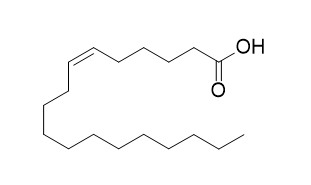Petroselinic acid
Petroselinic acid reduces the concentration of arachidonic acid in tissue lipids of rats.
Inquire / Order:
manager@chemfaces.com
Technical Inquiries:
service@chemfaces.com
Tel:
+86-27-84237783
Fax:
+86-27-84254680
Address:
1 Building, No. 83, CheCheng Rd., Wuhan Economic and Technological Development Zone, Wuhan, Hubei 430056, PRC
Providing storage is as stated on the product vial and the vial is kept tightly sealed, the product can be stored for up to
24 months(2-8C).
Wherever possible, you should prepare and use solutions on the same day. However, if you need to make up stock solutions in advance, we recommend that you store the solution as aliquots in tightly sealed vials at -20C. Generally, these will be useable for up to two weeks. Before use, and prior to opening the vial we recommend that you allow your product to equilibrate to room temperature for at least 1 hour.
Need more advice on solubility, usage and handling? Please email to: service@chemfaces.com
The packaging of the product may have turned upside down during transportation, resulting in the natural compounds adhering to the neck or cap of the vial. take the vial out of its packaging and gently shake to let the compounds fall to the bottom of the vial. for liquid products, centrifuge at 200-500 RPM to gather the liquid at the bottom of the vial. try to avoid loss or contamination during handling.
BMC Complement Altern Med.2016, 16:213
Korean Herb. Med. Inf.2021, 9(2):231-239.
Medicinal Chemistry Research 2021, 30:1117-1124.
Plant Science2024, 338:111914
J Chromatogr B Analyt Technol Biomed Life Sci. 2017, 1064:115-123
Environ Toxicol.2019, 34(12):1354-1362
Biol Pharm Bull.2018, 41(11):1645-1651
VNU J of Science: Med.&Pharm. Sci.2023, 39(1):20-29.
Food Sci Biotechnol.2024, 33(15):3629-3637.
ACS Omega.2023, 9(1):1278-1286.
Related and Featured Products
Plant ence, 1989, 64(2):167-177.
The effects of different cultural conditions on the accumulation of depot lipids notably petroselinic acid during somatic embryogenesis in Daucus carota L.[Reference:
WebLink]
METHODS AND RESULTS:
Total lipid content and the fatty acid composition of total lipids (TL), of triacylglycerols (TAG), and of total poplar lipids (PL) were investigated in tissue culture and somatic embryoids of Daucus carota L. Total lipids were approx. 0.2% of fresh weight in callus and suspension culture but approx. 0.5% in heart and torpedo shaped embryoids. Petroselinic acid (), which is approx. 70% of carrot seed oil, was not present in callus, suspension culture (0 time) and globular embryoids. The appearance of this fatty acid started in the heart shaped embryoids and reached a maximum level of 1.4% in the TAG of torpedo shaped embryoids. The major fatty acids invariably in all kinds of tissues where linoleic (18:2) and palmitic (16:0) acids, and the minor ones were stearic (18:0), oleic (), vaccenic () and linolenic (18:3) acid. Different cultural conditions could not boost Petroselinic acid accumulation but did increase TAG content in total lipids and total lipids in embryoids with a maximum level of approx. 17 mg TAG per g fresh weight. Abscisic acid, sorbitol and these in combination gave the maximum level of total lipids per g fresh weight; approx. 75% of the lipids were TAG.
CONCLUSIONS:
The results from this study, showing low levels of Petroselinic acid in later stages embryoids but not in undifferentiated tissues point to weak but distinct embryo specific expression of gene(s) governing the biosynthesis of Petroselinic acid.
Pharmaceutical Biology, 1993, 31(1):35-37.
Petroselinic Acid from the Ripe Berries of Aralia spinosa.[Reference:
WebLink]
METHODS AND RESULTS:
Activity-directed fractionation of the 95% ethanol extract of the berries of Aralia spinosa L. (Araliaceae) led to the isolation of cis-6-octadecenoic acid (1) (Petroselinic acid) as the major bioactive compound. This is the first report of this compound being isolated from the genus Aralia and of its toxicity. In this paper we reported the complete spectral data of 1.



